![]() 1st Battalion 22nd Infantry
1st Battalion 22nd Infantry ![]()
The 22nd Infantry during the World War 1917-1918
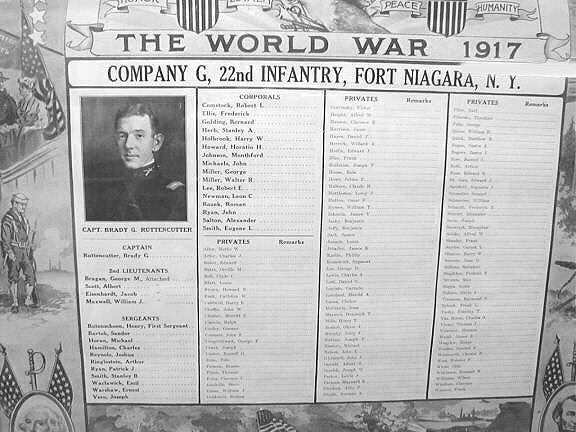
Souvenir of G Company
22nd Infantry's service
at Ft Niagara 1917
The following account is taken from an offical history of the 22nd Infantry Regiment, written in 1922.
Service in the World War
Immediately following the
declaration of war, on April 6, the First Battalion, 22nd
Infantry,
proceeded from Fort Jay to Hoboken, New Jersey, where they
transferred the crews of the German ships
lying alongside the great North German Lloyd and Hamburg-American
line piers,
from their ships to Ellis Island, New York harbor, where they
were interned.
This action was, beyond all
doubt, the first act of war committed by the armed forces of the
United States against Germany.
The transfer of the German sailors was effected in a quiet and
orderly manner, and without resort to force of any sort.
On the completion of this duty the First Battalion returned to
Fort Jay.
The Third Battalion of the regiment acted as guard at Ellis
island from April 12 to April 20.
It was not long before the
Government realized that not only was the property and shipping
of the great German lines in Hoboken of such enormous value that
it must be protected and guarded,
but also that the piers and deep-water slips afforded facilities
for the handling of overseas shipments
of either men or supplies, which were unequalled at any other
port in the country.
As a result of this viewpoint, the Second Battalion, 22nd
Infantry, was ordered from its station at Fort Totten,
New York, to the piers in Hoboken, on April 18, 1917, the order
being received
while the battalion was on a practice march about one mile from
the post at 10:30 A. M.
The command was marched back to Fort Totten at double time,
packed up its full field equipment,
and left for Hoboken by boat at 3:30 on the afternoon of the same
day.
The battalion reached Hoboken at about 8 p. M., April 18, and
immediately went into quarters on the piers,
Companies E and F taking over the Hamburg-American line section,
while Companies G and H
were quartered on the North German Lloyd side.
The officers of the Second Battalion at this time were as follows:
Captain George N. Bomford,
commanding the battalion and Company H.
1st Lieutenant J. B. Bennett, Jr., commanding Company G, and
acting battalion adjutant.
Captain J. H. Van Horn and Second Lieutenant D. S. Appleton,
Company E.
Second Lieutenant J. V. Ware, Company F.
Second Lieutenant F. M. Van Natter, Company G.
Second Lieutenant J. A. Anderson, Company H.
Within the course of two or
three days a thorough system was devised for the proper guarding
of the piers and ships,
and the battalion entered upon a tour of guard duty that lasted
for many months.
June 22, 1917, Companies A, B, F, G, K and L left their
respective stations at Fort Jay and Fort Hamilton
and proceeded by rail to the New Jersey State Rifle Range at Sea
Girt, New Jersey, where annual target practice was held.
Throughout this practice the troops lived under canvas at Camp
Edge, named for the governor of the state.
The above organizations returned to their proper stations July
14, and on the following day
Companies C, D, E, H, I, M, machine gun company and supply
company left for Camp Edge
to fire the prescribed annual course. The latter units left Sea
Girt and returned to their proper stations on July 25.
August 3, 1917, the 22nd
Infantry was called upon to furnish three officers and 400
enlisted men for immediate duty overseas.
At a conference of the field officers and company commanders held
at regimental headquarters on that day,
the enlisted personnel for this detail were selected, each on
account of some specific qualification,
such as motorcyclists, automobile and truck drivers, horsemen,
horseshoers, wagoners,
mechanics and telegraphers. This detachment was transferred to
headquarters troop,
headquarters train and military police of what was then termed
the First Expeditionary division
and later became famous as the First Division, American
Expeditionary Forces.
The officers selected were as
follows:
Captain George F. Rozelle, Jr., to command the headquarters
troop;
First Lieutenant P. K. Kelly, to command the first company;
Second Lieutenant Charles W. Yuill, to command the second
company.
It is unfortunate that it is not
within the province of this book to follow the subsequent careers
of these men in France,
but theirs is the history of the First Division rather than the
22nd Infantry. Suffice it to say,
that the officers and men ultimately became distributed among
nearly all the organizations of the First Division,
and throughout their service conducted themselves in a manner of
which their old regiment may well be proud.
Captain Rozelle was awarded the Distinguished Service Cross, and
Captain Yuill was cited in orders for gallantry
on five separate occasions. Regimental Sergeant-Major Patrick
Regan, who had been transferred from duty
as first sergeant of Company H, 22nd Infantry, was the recipient
of the Congressional Medal of Honor.
Many of these men never again returned to the United States, but
of those who did,
a large percentage re-enlisted in the 22nd Infantry.
In September, 1917, the
regimental supply company was attached to the 42nd National Guard
division,
then being mobilized at Camp Mills, Garden City, Long Island; and
a detachment of three officers
and sixty-one enlisted men was detailed to perform guard duty at
Camp Merritt, New Jersey,
from September 1 to September 21.
During the same month, Colonel
Tillson was placed on temporary detached service
as in command of the Port of Embarkation, in Hoboken,
and Major Russell V. Venable assumed command of the regiment.
Colonel Tillson and Captain Rush B. Lincoln, regimental adjutant,
returned to duty with the regiment the following month.
October 23, 1917, after six months of continuous guard duty on
the Hoboken piers, Companies E, F and H
were relieved from that duty and transferred to Fort Hamilton,
New York, for station.
Company G remained temporarily at Hoboken in order to turn over
in detail
the information essential to continual guarding of the piers by
the incoming troops of the 13th Infantry.
On the same day, Company I proceeded to Fort Niagara, New York,
leaving detachments performing guard duty
at Clayton and Black Rock, New York. Detachments of Company K
were sent also to Ellis Island
and the Morse Dry Dock Company, in Brooklyn, for duty, while
Company L was transferred from Fort Hamilton
to Frankford arsenal, Pennsylvania, furnishing detachments for
guard at Cramp's Shipbuilding Company,
Philadelphia and Gloucester, New Jersey. Company M changed
station from Fort Hamilton to Fort Niagara, New York,
and on November 27, Company H also left Fort Hamilton for station
at Plattsburg Barracks, New York.
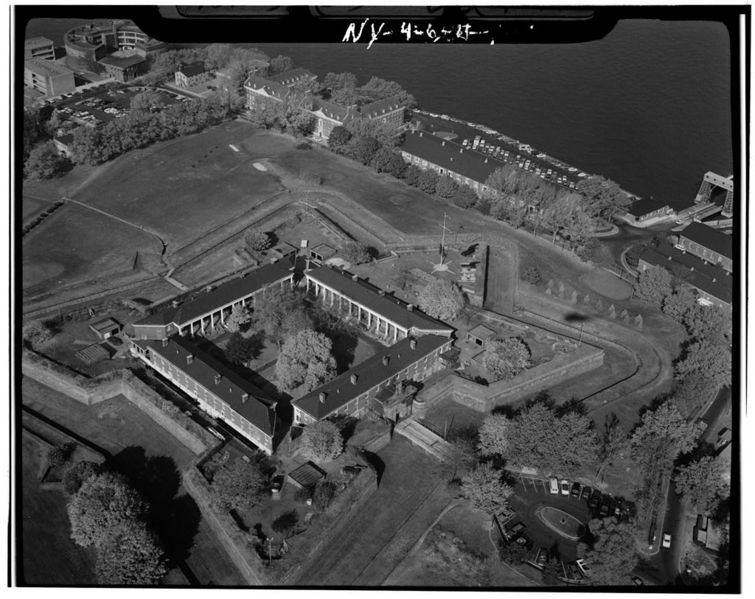
Fort Jay, New York
Though this photo was
taken much later, the fort remains much as it would have looked
during the World War
During the month of December, 1917, the following changes of stations and duties of the units of the regiment occurred:
One officer and 38 enlisted men
of Company F, from Fort Hamilton
to Lehigh Valley Railroad piers, Jersey City, N. J., on December
13;
Two officers and 28 enlisted men
of Company F, from Fort Hamilton
to the National Dock Company's piers on Black Tom Island, New
Jersey;
Company G, from the
Hamburg-American line piers, Hoboken, New Jersey,
to the New York Dock Company's piers, Columbia Heights, Brooklyn,
N. Y.
Company K furnished a detachment
of two officers and 59 men for guard duty at Ellis Island, N. Y.,
and another detachment of two officers and 51 enlisted men for
the same duty
at the Morse Dry Dock and Repair Company, at Brooklyn, N. Y.
Eighteen enlisted men of the
machine gun company were placed on detached service from Fort
Hamilton
and assigned to duty at the New York Dock Company in Brooklyn on
December 30.
January 29, 1918, Company D, consisting of three officers and 79
enlisted men, proceeded to Kearney Meadows,
New Jersey, where they were detailed to guard the Foundation
Shipbuilding Company.
The only other change of station during the month was that of
Company E, which was transferred from Fort Hamilton
to Madison Barracks., N. Y., January 8-9. Company D returned to
Fort Jay from Kearney Meadows on February 3.
March 13, one officer and 53 enlisted men of Company K,
comprising the detachment on duty at Ellis Island,
were returned to Fort Hamilton, where they rejoined the company;
three officers and 54 enlisted men left Fort Hamilton
March 14, for duty as a guard over the docks and warehouses
utilized by the French High Commission.
This property was located at Franklin and Dupont Streets,
Greenpoint, Brooklyn.
The following month of April the organizations continued to make many changes of station; these were as follows:
April 1, 25 enlisted men of
Company G were attached to Company F,
a detachment of two officers and 59 men of this company was
detached as a guard at the Erie Railroad piers
in Jersey City, N. J., from April 2-27. On April 28, the entire
company, including the 25 men of Company G,
moved to Sandy Hook, New Jersey.
Company G left Columbia Heights, Brooklyn, on April 4 and proceeded to Howard Place, Bayonne, New Jersey.
April 16, Company K, three
officers and 63 men, was transferred by rail from the French High
Commission Docks
to Gloucester, New Jersey, there to act as a guard at the Pusey
and Jones Shipbuilding Company.
May 13, 1918, the supply
company, 22nd Infantry, having completed its duties
in connection with the 42nd Division at Camp Mills, Long Island,
moved by wagon train
from that place to Fort Hamilton; total distance covered, 35
miles.
Companies A and D moved from
Fort Jay, N. Y., to Camp Edge, Sea Girt, New Jersey, for target
practice,
August 9, 1918. The two companies returned to Fort Jay August 20.
1st Battalion Serves as the Capitol Guard in Washington, D.C.
August 21, Companies B and C
left Fort Jay for East Potomac Park, Washington, D. C.
They arrived in Washington, D. C., at 6:00 A. M. the following
day.
Companies A and D followed as soon as possible, and reached
Washington at 6:00 A. M. August 24.
Company E was transferred from
Madison Barracks, New York, to Fort Jay, arriving at the latter
post
at 9:00 A. M. August 21. On the same day, Company F was
transferred from Sandy Hook to Fort Jay,
and Company I moved from Fort Niagara to Fort Jay, arriving on
August 24.
Company L was also transferred to Fort Jay, leaving Frankford
Arsenal, Pa., on the morning of August 27
and arriving at Fort Jay at 3:30 P. M. the same day.
August 8-9, .1918, Company G moved from the Elco Boat plant,
Bayonne, New Jersey,
to the Syracuse Recruit camp, Syracuse, New York. August 26,
headquarters company proceeded from Fort Jay
to Camp Edge, Sea Girt, New Jersey, and returned from that
station September 7.

Above: John W. Pickel, a
soldier who served in Company F 22nd Infantry during World War
One. Confirmation of the entry
that Pickel sailed overseas in 1919 could not be found. After his
discharge Pickel returned to Illiopolis, Illinois where he
became a a section laborer for the Illinois Terminal Railroad
Company. He died at the age of 49 on November 22, 1946
and is buried in Riverside Cemetery in Illiopolis, Sangamon
County, Illinois.
Photo from The Honor Book Sangamon County Illinois 1917-1919 by Nellie Browne Duff 1920
From September 3-6, inclusive, a
so-called "slacker drive", or round-up of evaders of
the selective draft,
was held in New York City. Company F, 22nd Infantry, five
officers and 188 enlisted men,
was placed on duty in the city in connection with this movement.
The company had little to do
in aiding the draft authorities to pick up the delinquents, and
having been relieved from this duty on September 6,
proceeded, three days later, with Company L,, to Sea Girt, N. J.,
for target practice.
Both companies returned to Fort Jay on September 22.
October 10, Company E left Fort
Jay at 3:30 p. M., for Morgan, New Jersey, arriving at 6:00 p. M.
the same day.
A terrific explosion had just occurred in the powder magazines at
the government plant,
and this company was immediately dispatched as a guard. Company G
was transferred from the Syracuse Recruit camp
to Anatol, New Jersey, October 19.
On November 11, 1918, the
armistice was signed,
and all military operations against the enemy were suspended at
11 A. M. that day.
To say that the foregoing record
of almost continuous change of station of all the organizations
of the 22nd Infantry constitute a narrative of the part it played
in the World War would be a statement far from the truth.
It is, however, quite impossible to tell in detail of the long
and arduous tours of guard duty performed by the regiment
during the nineteen months of the war. That the regiment played a
highly important part in the government's plans
to defeat the enemy is beyond question, and the fact that of all
the millions of dollars' worth of property
entrusted to the regiment's care between April 6, 1917, and
November 11, 1918, not one atom was ever lost to the nation
or to an individual owner, speaks for the manner in which the
22nd Infantry accomplished its task
in words far more potent than can be set down in the pages of a
book.
**********************
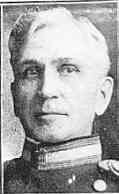
Colonel J.C.F. Tillson
Colonel John Charles Fremont Tillson commanded the 22nd Infantry Regiment from 1916 to 1920.
In 1917, with mobilization
underway, COL Tillsontook the regiment from Camp Harry Jones,
Arizona, to Fort Jay,
Governors' Island, New York, where, as commander of the 22nd
Infantry he also became commander of Fort Jay.
The draft had been instituted in 1917, when it became apparent
the United States would inevitably enter the World War.
Those who resisted the draft were brought to Governors' Island,
where it would be decided if they would serve in the military
or serve sentences of incarceration. As commandant, Colonel
Tillson had command over these men.
"Colonel Tillson...had charge of "slackers", men who failed to comply with the draft law.
In the opinion of competent observers, he handled a difficult problem with tact and
common sense. Scores of men who came before him, sullen and defiant, a few hours later left
Governors' Island for Camp Upton as anxious to get into the service as they
previously had been to avoid it. More than 95 per cent of the slackers he
interviewed later got ready enthusiastically and faithfully at Camp Upton to
'go over the top'.
At times he had to use as many as three interpreters to get to the bottom of the case of some
unfortunate who had American citizenship papers but could not understand a single
word printed on those documents. His experience in China, where he had to
communicate with Chinese through interpreters, then stood him in good stead."
The New York Times, Wednesday December 17, 1941
The port of New York, and more
officially, Governors' Island, was designated the port of
embarkation
for the US troops expected to be sent overseas to the War in
Europe. The 22nd Infantry Regiment would not be sent overseas,
but would be given the mission of guarding the docks at Hoboken,
New Jersey, against possible acts of sabotage or espionage.
As commandant of Fort Jay, Colonel Tillson was also given the job
of protecting the railroads leading into the city.
On April 6, 1917, at 3 a.m. war
was declared. However, Colonel Tillson had been ready and had
made plans in advance.
At one minute past 3 a.m. , he sent detachments of the 22nd
Infantry to the docks in Hoboken, where they took possession
of all ships of the North German Lloyd and Hamburg American
Lines. Altogether they seized 16 German ships,
including the Vaterland (later named the Leviathan) and took
their crews into custody.
By this seizure, well-planned by Colonel Tillson long in advance of the war declaration,
THE 22ND INFANTRY COMMITTED THE
FIRST ACT OF BELLIGERENCE BY THE UNITED STATES
AGAINST GERMANY IN WORLD WAR I.
The 22nd Infantry remained under Colonel Tillson's command at Governors' Island throughout the war.
In 1920 Colonel Tillson was retired from the US Army.
Edited from THE ELMIRA ADVERTISER, 1938 and 1941
*A heartfelt Thank You to Grace Paris, who graciously shared the above information about her grandfather, Col JCF Tillson.
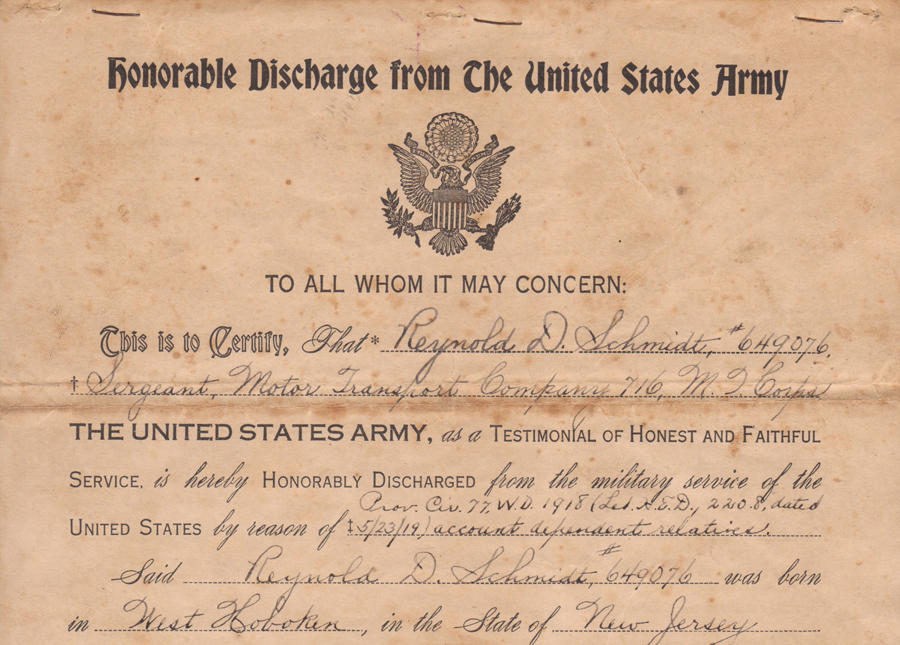
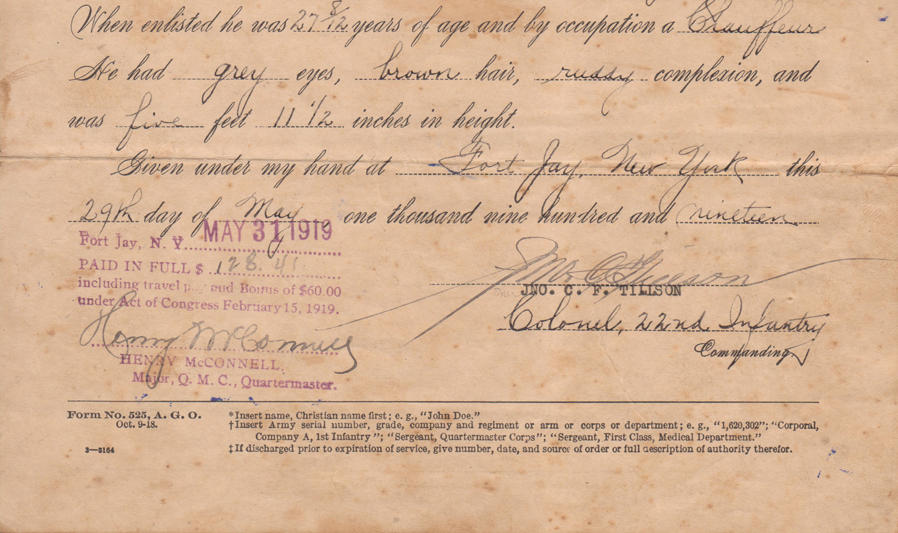
Above: Discharge of Sergeant Reynold D.
Schmidt of the 716th Motor transport Company stationed at Fort
Jay, New York.
Document is signed by Colonel John C.F. Tillson, Commanding
Officer of the 22nd Infantry and of the Post of Fort Jay.
Courtesy of John Willis, the grandson of Reynold D. Schmidt
**********************
The importance of the seizure of
the German ships by the 22nd Infantry should not be
under-estimated.
All of the seized vessels were pressed into American service, to
be used as cargo ships and troop carriers,
adding immensly to the movement of men and material across the
Atlantic to the war zone.
The USS Leviathan
One of the German ships seized
by the 22nd Infantry at Hoboken on April 6, 1917 was the
Vaterland (Fatherland).
After refitting and renovation, the ship was renamed the USS
Leviathan, and was used to ferry troops
to and from the European theatre of operations.
From 1914-1921 this was the largest ship of any kind afloat. She was 950 feet long and 100 feet wide, displacing 54,000 tons.
During the war the Leviathan
made 19 round trips across the Atlantic, carrying 10 % of all
American troops ferried.
In March of 1919 she brought home 14,416 troops on one run,
setting a world record
for the most people ever sailing on a single ship.
After the war the Leviathan once
again was refitted, and became a passenger liner from the years
1921-1934.
She was scrapped in 1938.
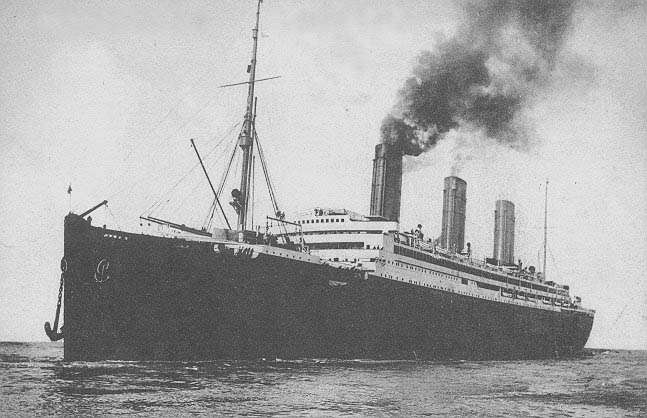
The Vaterland in a photo taken
before the war, and looking much as she would have
when seized by the 22nd Infantry.

The USS Leviathan, in her wartime camouflage paint, about to set out across the Atlantic.
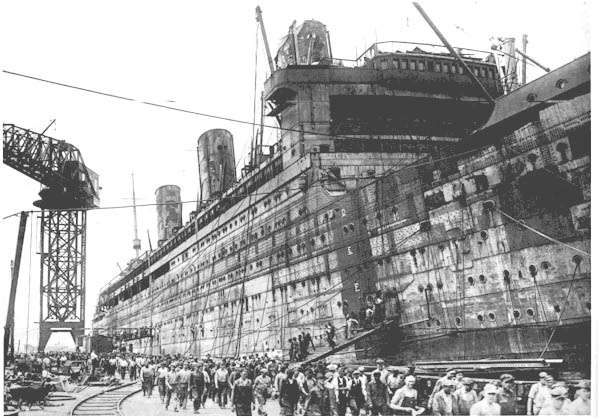
Workers leave the Leviathan
during one of her refittings.
Her immense size can be gauged by the size of the workers coming
down the fore and aft gangplanks.
For seven years this was the largest ship in the world.
Home | Photos | Battles & History | Current |
Rosters & Reports | Medal of Honor | Killed
in Action |
Personnel Locator | Commanders | Station
List | Campaigns |
Honors | Insignia & Memorabilia | 4-42
Artillery | Taps |
What's New | Editorial | Links |